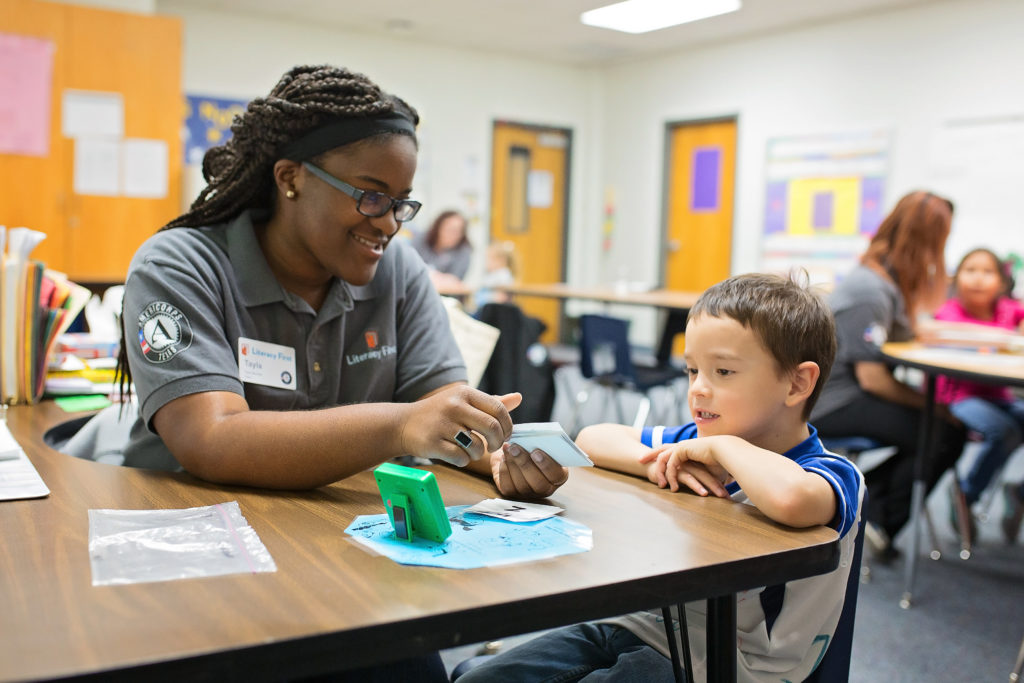Nearly 20 percent of children in Travis County live in poverty. Austin Woman spoke with Dr. Mary Ellen Isaacs about the importance of literacy and the effects of socio-economic status on education.
By Lauren Jones, Photo courtesy of Literacy First

The passionate leader behind Literacy First, a program that strives to close the learning gap for underprivileged students in Central Texas, Mary Ellen Isaacs is a woman on a mission. As a former reading teacher, she understands the importance of literacy, and has found her calling as executive director of this growing program.
“When a child never learns to read at grade level, that child is four times more likely than his or her peers to drop out of high school,” she says. “A vast majority of kids don’t have a reading problem; they just lack experiences and opportunities that other kids in higher-income households may have.”
Founded in 1994, Literacy First began in two Austin Independent School District schools, fostering partnerships with district and school staff. Now, with 90 full-time AmeriCorps tutors at its helm, the program is able to serve students in 22 Austin-area schools.
The model of Literacy First is simple. Each tutor works 20 to 30 minutes a day with a student, with the ultimate goal of closing the learning gap swiftly and effectively, and providing much-needed support for teachers. In any given school, half the students in kindergarten aren’t ready for it and two-thirds to three-fourths of the students show some risk of falling behind, Isaacs says, noting that it's a tall order for a teacher to fill.
In addition to acting as a support network for teachers and the district, Literacy First invests an unparalleled amount of time in training its staff and tutors, more so than many other tutoring programs. Tutors meet once a week to discuss their caseloads, troubleshoot any problems and personalize their lesson plans for the week, using reading benchmarks from each student to track progress. Literacy First’s data-driven approach is truly unique.
https://www.youtube.com/watch?v=NNxwiZ6zVtc&t=13s
Poverty and Education: The Defining Line
Children who live in poverty have a higher number of school absences than their peers. Therefore, those students are more likely to fall behind, and when that does happen, schools may not be able to fill that gap. That is where Literacy First comes in.
“We work very closely with the district leadership to choose which schools are right for the program,” Isaacs says. “All are Title I [high-poverty] schools, where the average family of four makes less than $40,000 a year.”
While Travis County may not seem impoverished, nearly 20 percent of all residents live below the poverty line.
“There really are two Austins: There is the Austin that is thriving and growing, but there are a large number of Austinites that are struggling as the cost of living goes up,” Isaacs says.
The Cost of Education
Private tutoring is expensive, but it becomes more difficult to close the learning gap past second grade, when reading is used as a tool for comprehension. That is why Literacy First works with students in kindergarten through second grade, so by the time the students reach third grade, they are well on their way to success.
Every year, about 75 percent of Literacy First students learn to read at grade level after an average of six to eight weeks in the program, with all excelling past their baseline. Once a child reaches his or her reading goals, another student is selected from the waiting list.
Dr. Mary Ellen Isaacs’ Top Tips
“The most important thing you can do is to read to your children,” Isaacs says. “They are never too old to be read to, and gain so much from it.”
Additionally, it is important to provide opportunities to engage in conversations. Talk about the events of the day with your children or even head to the library after school.
Education is the most important factor in determining success later in life and is key in communities striving to reduce poverty rates.
Those looking to give back and get involved with Literacy First should check out the organization’s annual Study Social Aug. 18 from 8 to 11 p.m. Tickets are $40 ahead of time and $50 at the door.








